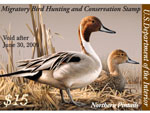
2008 FEDERAL DUCK STAMP CONTEST Phone: 618-883-2524 |
Prescribed fire is a tool used by refuge managers to improve the quality of habitat in fire-dependent plant communities. Properly timed and controlled fires can improve the growth of desirable plant species in many habitats.
In the absence of periodic burns; plant and wildlife diversity decrease over time. Grasslands are overtaken by brush and small trees and grassland dependent bird species such as the bobolink and Henslow's sparrow may disappear. Fire is also a valuable tool in managed wetlands, where periodic disturbance is needed to set back the encroachment of woody vegetation and other undesirable plants. Undisturbed forest understory may be overtaken by tree and shrub species that shade out woodland grasses and wildflowers.

A Refuge staff member ignites a fireline during a prescribed fire
Long before any prescribed fire is ignited, a detailed plan is developed by a designated prescribed fire specialist. The plan considers the current condition of the site; biological results desired; people and equipment needed; adjacent land types, buildings, roads, and communities; required weather conditions; as well as contingency plans in case of emergency. Each member of the fire crew must meet specific training and physical fitness requirements.
Weather and fuel conditions are closely monitored and must be within guidelines before a fire is ignited. Once the decision is made to start a burn, the burn boss coordinates with individuals and agencies that may have concerns about the fire, such as local landowners, fire departments, and police departments. Following the fire season, post-burn biological monitoring is conducted to ensure that the desired objectives have been met.

